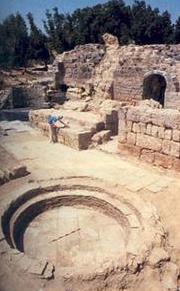Hammat Gadar (or Gader) Roman Baths
Arguably the most important bath in the Holy Land, and one of the largest spas in the Roman world, is Hammat-Gader, near the Sea of Galilee. The emperor Caracalla came here (in addition to Hammei-Tiberias), as did Hadrian (117–138 A.D.), who had dermatological problems.
The Greek biographer Eunapius (fourth century A.D.) wrote that the baths of Hammat-Gader “are second only to those at Baiae [in the Bay of Naples] with which no other baths can be compared throughout the Roman world.” Eunapius tells us that even people from Athens flocked to Hammat-Gader in search of a cure.
The Roman-period bath is a monumental structure (see photos). Roughly rectangular, it occupied an area of nearly 54,000 square feet. The excavators, Yizhar Hirschfeld and Giora Solar, who uncovered the well-preserved bathhouse buildings, found it magnificently built, with a branched network of channels, pipes and tunnels that conducted the mineral and fresh water, and drained the pools. They gave the various rooms in the building names like the Hall of the Fountains, the Hall of the Inscriptions and the Hall of the Pillars. Each contains a large pool connected with the others. The water emerges at a temperature of 125F from the hottest spring in the southwestern part of the thermal complex. It’s called ‘Ain el-Maqle, the Spring of Burning, and its water circulated via channels into various other pools. One pool that is not connected with the others is the so-called Lepers’ Pool. It was located in a separate architectural unit that had entrances that could be closed off. In this pool a large quantity of clay oil lamps was found, all very similar in style, and all free of the soot that clings to a lamp after use; these lamps had never been used as lights, but were intended as part of the midnight ritual to cure lepers.
A pilgrim named Antoninus, from the Italian town of Placentia, visited the spa in 570 A.D. and recorded in detail how lepers were healed at Hammat-Gader—then known as Thermae Heliae, the Baths of Elijah. In his Itinerarium he describes the practice of “incubation,” which was common at the ancient centers of Aesculapius-
In front of the basin [ante clibanum] is a large pool. When it is full, all the gates are closed, and they [the lepers] are sent in through a small door with lights and incense and sit in the pool all night. They fall asleep, and the person who is going to be cured sees a vision. When he has told it, the springs do not flow for a week. In one week he is cleansed.
Excerpted from Estee Dvorjetski, “Healing Waters- The Social World of Hot Springs in Roman Palestine,” BAR 30-04, Jul-Aug 2004.
See also-
- BibleWalks.com- Hammat Gader
- Y. Hirschfeld, The Roman Baths of Hammat Gader, Israel Exploration Society, Jerusalem, 1997.
- Hammat Gader Synagogue, 450 CE
